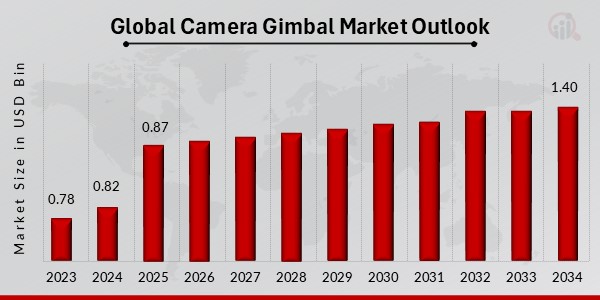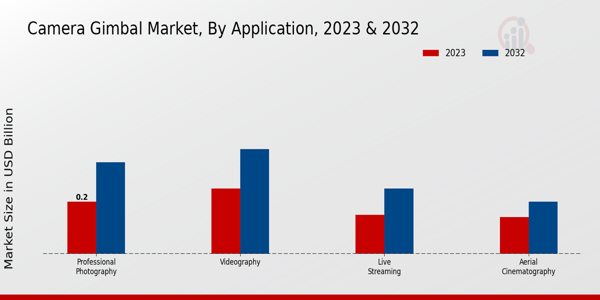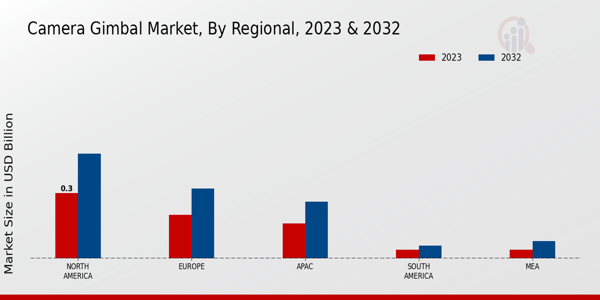Global Camera Gimbal Market Overview
Global Camera Gimbal Market Size was estimated at 0.82 (USD Billion) in 2024. The Camera Gimbal Market Industry is expected to grow from 0.87 (USD Billion) in 2025 to 1.40 (USD Billion) by 2034. The Camera Gimbal Market CAGR (growth rate) is expected to be around 5.48% during the forecast period (2025 - 2034).

Source Primary Research, Secondary Research, MRFR Database and Analyst Review
Key Camera Gimbal Market Trends Highlighted
The Camera Gimbal Market is gaining a good momentum due to the increasing need for stable and quality video production for a wide range of usages including filmmaking, Live Events, and content creation. Also, with the growing number of social media or vlogging influencers, there is always an increase and need for better stabilization techniques that enhance video quality. Innovative gimbal design and manufacturing approaches employing advanced motor systems along with low weight materials further trigger the growth of the market. These developments have made it possible to effectively capture video without any shaking or distortion and made it possible to use varying types of cameras ranging from phones to professional camcorders.
There are several opportunities in the market to grow further. The growth trends for virtual reality (VR) and augmented reality (AR) content are expected to increase the gimbal’s that are designed for such formats. In the future, camera drones might integrate gimbal systems for aerial photography as the drone technologies improve. Online sales platforms coupled with video tutorials has great potential for manufacturers of gimbals who are focused on selling their products to beginners and hobby enthusiasts. In addition to hardware, companies can leverage the availability of stabilization apps as part of their gimbal systems to enhance customer user satisfaction.Recently, there has been a noticeable trend towards compact and portable gimbals. Consumers are seeking lightweight options that are easy to transport, especially for travel and on-the-go filmmaking. Furthermore, the emergence of hybrid gimbals that combine features like stabilization with camera operation capabilities is gaining traction. This transition reflects a broader shift towards multifunctional equipment that caters to the diverse needs of creators. As the industry continues to evolve, the focus will broaden to include sustainability and the use of eco-friendly materials in gimbal production, advancing the market further.
Camera Gimbal Market Drivers
Increasing Demand for High-Quality Video Content
The Camera Gimbal Market Industry is experiencing a significant surge in demand driven by the increasing need for high-quality video content across various sectors. With the advent of social media platforms and the growing popularity of video-based content, individuals and businesses alike are investing in equipment that allows for the creation of professional-grade videos. This demand is not only felt among professional videographers but also among influencers, content creators, and hobbyists who wish to elevate their production quality.As consumers continue to seek engaging and visually appealing video material, the market for camera gimbals is expected to grow substantially. Camera gimbals play a crucial role in stabilizing shots, thereby enabling smoother camera movements, which is essential for creating captivating video content. This trend is reflected in the increasing sales of camera gimbals, with users recognizing the value these devices add in terms of production quality.As the appetite for high-quality video content expands, so does the necessity for effective stabilization tools, positioning camera gimbals as essential equipment in the workflows of various content creators. By enhancing the visual appeal of content, gimbals not only enhance the quality but also contribute to the market's growth as users are more inclined to invest in technology that streamlines their production processes. Additionally, the rise of professional live-streaming events and online video-sharing platforms has catalyzed this market growth, further solidifying the role of gimbals within the Camera Gimbal Market Industry.
Technological Advancements in Stabilization Solutions
The Camera Gimbal Market Industry is significantly driven by rapid technological advancements in stabilization solutions. Manufacturers are continuously innovating to improve the features and functionalities of camera gimbals, such as enhanced motors, improved battery life, and advanced software algorithms that ensure seamless stabilization during capture. As a result, users are increasingly adopting gimbal systems that cater to their diverse filming needs, whether for cinematic productions or everyday vlogging.This technology evolution not only leads to better user experiences but also bolsters the attractiveness of these products in a competitive market.
Rising Popularity of Aerial Photography and Videography
The popularity of aerial photography and videography is rapidly growing, particularly in industries such as real estate, tourism, and filmmaking. This trend has significantly impacted the Camera Gimbal Market Industry as gimbals are critical for stabilizing drones and camera equipment during flight. As more people explore alternative methods of capturing stunning visuals from above, the demand for high-quality aerial imagery continues to increase.Gimbals enhance the overall quality of aerial shots, making them more appealing and professional, thus driving growth in the camera gimbal sector.
Camera Gimbal Market Segment Insights
Camera Gimbal Market Application Insights
The Camera Gimbal Market is experiencing notable growth across various applications, which is reflective in its projected market valuations. In 2023, the market is expected to achieve a valuation of 0.74 USD Billion, growing to an estimated 1.2 USD Billion by 2032, indicating a healthy potential within this sector. Professional Photography stands out with a valuation of 0.2 USD Billion in 2023, expanding to 0.35 USD Billion in 2032. This segment is significant due to the increasing demand for high-quality images, achievable through the stability and versatility that camera gimbals provide.Videography holds a substantial share as well, valued at 0.25 USD Billion in 2023 and set to rise to 0.4 USD Billion by 2032; the demand for content creation, especially in events and film production, drives this segment's prominence. Meanwhile, Live Streaming is gaining traction, projected to rise from 0.15 USD Billion in 2023 to 0.25 USD Billion in 2032, as the shift to online platforms for broadcasting events increases the need for stable video capture. Similarly, Aerial Cinematography, valued at 0.14 USD Billion in 2023 and expected to grow to 0.2 USD Billion by 2032, emphasizes the growing interest in drone photography and cinematic shots from unique perspectives.The demand fluctuations in these segments highlight the ongoing technological advancements and the increasing adoption of camera gimbals by both professionals and enthusiasts, which contribute to the overall growth trajectory of the Camera Gimbal Market and its segmentation. The market growth is further fueled by the rising popularity of platforms that prioritize high-quality video content and superior imagery, alongside an expanding base of consumers engaging in creative content production.

Source Primary Research, Secondary Research, MRFR Database and Analyst Review
Camera Gimbal Market Type Insights
The Camera Gimbal Market, valued at 0.74 USD Billion in 2023, is experiencing steady expansion, driven by advancements in imaging technology and rising demand for high-quality visuals. The market segmentation showcases various types, including Handheld Gimbals, Wearable Gimbals, Tripod Gimbals, and Drone Gimbals, each catering to different user needs. Handheld Gimbals dominate the market as they offer portability and versatility for videographers, while Wearable Gimbals are gaining traction among action enthusiasts who require stability in dynamic environments.Tripod Gimbals, known for their precision, play a significant role in professional settings, ensuring stability during shoots. Drone Gimbals are pivotal in aerial cinematography, enabling smooth footage capture from flights. The growing trend of social media content creation and the increasing adoption of drones enhance the importance of these segments, which are projected to continue driving the market’s future growth. Adopting innovative designs and features will present profitable opportunities while also encountering challenges such as high competition and the need for continuous technological improvements in the Camera Gimbal Market industry.Overall, the market is set to reach a valuation of 1.2 USD Billion by 2032, reflecting a solid growth trajectory and emerging trends across its types.
Camera Gimbal Market Payload Capacity Insights
The Payload Capacity segment within the Camera Gimbal Market plays a vital role in determining the suitability of gimbals for various applications, influencing overall market growth. In 2023, the market was valued at 0.74 billion USD, and this area is expected to show notable performance driven by growing demand in sectors like filmmaking, photography, and live streaming. The distinction among Lightweight, Mid-weight, and Heavyweight gimbals is crucial, as Lightweight options cater to portable applications, making them popular among amateur videographers.Meanwhile, Mid-weight solutions often serve professional users who require a balance between portability and stability, helping drive a significant portion of the market. Heavyweight gimbals dominate high-end productions where stability is essential, such as in action filmmaking and broadcasting, thus holding a majority share. This segmentation underlines the diverse range of user needs and application scenarios, which propels the development of innovative products tailored to specific payload requirements. The Camera Gimbal Market data reflects a clear trend toward specialization, as manufacturers focus on enhancing payload capacity to meet evolving consumer expectations and industry standards.This evolution within the segment, supported by user-friendly technology and improved design, presents opportunities for growth and innovation in the Camera Gimbal Market industry.
Camera Gimbal Market Distribution Channel Insights
The Camera Gimbal Market, valued at 0.74 USD Billion in 2023, shows a diverse Distribution Channel landscape that caters to various consumer preferences and purchasing behaviors. Online Retail has gained prominence in recent years, driven by the convenience of e-commerce and a growing number of consumers turning to digital platforms for their purchases. This segment holds a substantial share due to its ability to offer a wide range of products and competitive pricing. Offline Retail continues to play a critical role, appealing to customers who prefer in-person shopping experiences and the ability to physically examine products before buying.Direct Sales also contribute significantly, particularly among professional users and businesses that require tailored solutions. The interplay among these channels reflects a change in consumer shopping patterns influenced by technology advancements and market trends, enhancing overall accessibility. The Camera Gimbal Market revenue forecast suggests that these distribution channels will evolve further, adapting to consumer demands, and offering exciting opportunities for growth moving forward. The market statistics reveal that each channel presents unique advantages, requiring companies to strategize effectively in their marketing and distribution efforts.
Camera Gimbal Market Regional Insights
The Camera Gimbal Market is characterized by significant regional dynamics. In 2023, North America emerged as the leading region, holding a majority with a market valuation of 0.3 USD Billion, projected to rise to 0.48 USD Billion by 2032, reflecting its strong inclination towards advanced filming technology. Europe follows with a significant presence, valued at 0.2 USD Billion in 2023, anticipated to increase to 0.32 USD Billion, indicative of the region's robust consumer base for photography equipment. The Asia-Pacific (APAC) region is also noteworthy, accounting for 0.16 USD Billion in 2023 and expected to reach 0.26 USD Billion, demonstrating growing adoption of gimbal systems for creative filmmaking and content creation.Meanwhile, South America and the Middle East Africa (MEA) represent smaller segments, each valued at 0.04 USD Billion in 2023, with gradual growth to 0.06 USD Billion and 0.08 USD Billion, respectively, reflecting the emerging market potential. Notably, North America's advanced market infrastructure and consumer demand significantly drive the Camera Gimbal Market revenue, while Europe and APAC are crucial in terms of growth potential, promoting increasing market statistics through enhanced product innovation and competitive dynamics.

Source Primary Research, Secondary Research, MRFR Database and Analyst Review
Camera Gimbal Market Key Players and Competitive Insights
The Camera Gimbal Market is characterized by an increasingly competitive landscape that has seen significant growth due to the rising demand for stabilized imaging technology across various sectors, including film production, live broadcasting, and content creation. The market is populated by multiple players who are engaged in continuous innovations to enhance their product offerings, targeting both amateur and professional filmmakers. In this dynamic environment, companies are focusing on developing advanced features such as improved stabilization technology, lightweight designs, and user-friendly interfaces to attract a wider customer base. Moreover, collaboration with emerging technologies like smartphones and drones has opened up new avenues, further intensifying competition among market participants.Sony holds a strong position in the Camera Gimbal Market, leveraging its robust reputation and technological prowess in the imaging space. The company is recognized for its commitment to research and development, leading to cutting-edge gimbal solutions that cater to various filming scenarios. With a strong emphasis on product quality and performance, Sony consistently introduces gimbals that offer exceptional stabilization and ease of use, appealing to both professional filmmakers and enthusiasts alike. The company's market presence is underscored by widespread distribution channels and a loyal customer base, making it a formidable player. Furthermore, Sony’s integration of its gimbals with other imaging equipment showcases its ability to create a cohesive ecosystem that enhances user experience.Panasonic also plays a vital role in the Camera Gimbal Market, known for its innovative approach and high-quality imaging products. The company's gimbals are often praised for their durability and effective stabilization, which are critical for both amateur and professional videographers seeking reliable solutions for capturing high-quality footage. Panasonic leverages its expertise in the broader electronics market, allowing it to design gimbals that are not only functional but also compatible with a wide range of cameras, ensuring versatile usage. Additionally, Panasonic maintains a strong brand presence in the industry, driven by its commitment to supporting content creators with dependable technology that helps elevate the quality of visual storytelling. Through continuous improvements and adaptations to market trends, Panasonic seeks to remain competitive and relevant in the ever-evolving landscape of camera gimbals.
Key Companies in the Camera Gimbal Market Include
- Sony
- Panasonic
- Gudsen
- Bebop
- Zhiyun
- Canon
- Feiyu Tech
- Vanguard
- Swivl
- Moza
- Manfrotto
- DJI
- RoboMaster
- Benro
- GoPro
Camera Gimbal Market Industry Developments
Recent developments in the Camera Gimbal Market indicate a growing focus on advanced technology and user-friendly features, with companies like DJI, Zhiyun, and Moza leading the charge in creating innovative gimbal solutions that cater to both amateur and professional videographers. Expanding product lines by companies such as Sony and Panasonic emphasize portability and enhanced stabilization, driving interest among content creators. Notably, DJI continues to enhance its market position through new product announcements and upgrades, maintaining strong sales figures. There have also been discussions around collaborations and partnerships aimed at integrating artificial intelligence into gimbal technology, enhancing usability. Meanwhile, companies like Gudsen and Feiyu Tech are witnessing growth in market valuation as demand for lightweight and versatile gimbals increases. The competitive landscape remains dynamic, with Canon and GoPro exploring strategic initiatives to align their offerings with consumer preferences. However, there have been no major mergers or acquisitions reported among the specified companies in this sector, keeping the market's competitive nature intact.
Camera Gimbal Market Segmentation Insights
Camera Gimbal Market Application Outlook
- Professional Photography
- Videography
- Live Streaming
- Aerial Cinematography
Camera Gimbal Market Type Outlook
- Handheld Gimbals
- Wearable Gimbals
- Tripod Gimbals
- Drone Gimbals
Camera Gimbal Market Payload Capacity Outlook
- Lightweight
- Mid-weight
- Heavyweight
Camera Gimbal Market Distribution Channel Outlook
- Online Retail
- Offline Retail
- Direct Sales
Camera Gimbal Market Regional Outlook
- North America
- Europe
- South America
- Asia Pacific
- Middle East and Africa
| Report Attribute/Metric |
Details |
| Market Size 2024 |
0.82 (USD Billion) |
| Market Size 2025 |
0.87 (USD Billion) |
| Market Size 2034 |
1.40 (USD Billion) |
| Compound Annual Growth Rate (CAGR) |
5.48% (2025 - 2034) |
| Report Coverage |
Revenue Forecast, Competitive Landscape, Growth Factors, and Trends |
| Base Year |
2023 |
| Market Forecast Period |
2025 - 2034 |
| Historical Data |
2019 - 2023 |
| Market Forecast Units |
USD Billion |
| Key Companies Profiled |
Sony, Panasonic, Gudsen, Bebop, Zhiyun, Canon, Feiyu Tech, Vanguard, Swivl, Moza, Manfrotto, DJI, RoboMaster, Benro, GoPro |
| Segments Covered |
Application, Type, Payload Capacity, Distribution Channel, Regional |
| Key Market Opportunities |
Rising demand for content creation, Growth in travel and adventure photography, Advancements in stabilization technology, Increasing use in live streaming, Integration with smartphone capabilities |
| Key Market Dynamics |
Increasing demand for stabilizers, Growth in mobile filmmaking, Advancements in gimbal technology, Rising adoption in sports events, Expanding influencer and content creator market |
| Countries Covered |
North America, Europe, APAC, South America, MEA |
Frequently Asked Questions (FAQ) :
The Camera Gimbal Market is anticipated to reach a value of 1.40 USD Billion by 2034.
In 2023, the market value of the Camera Gimbal Market was 0.78USD Billion.
The Camera Gimbal Market is expected to grow at a CAGR of 5.48% from 2025 to 2034.
North America is expected to hold the largest market share, valued at 0.48 USD Billion by 2032.
The Professional Photography application is projected to be valued at 0.35 USD Billion by 2032.
The Videography application is expected to reach a value of 0.4 USD Billion by 2032.
The Live Streaming application is expected to be valued at 0.25 USD Billion by 2032.
Key players in the Camera Gimbal Market include Sony, Panasonic, DJI, and Canon among others.
The APAC region is projected to grow, reaching a market size of 0.26 USD Billion by 2032.
The Aerial Cinematography application was valued at 0.14 USD Billion in 2023.

















